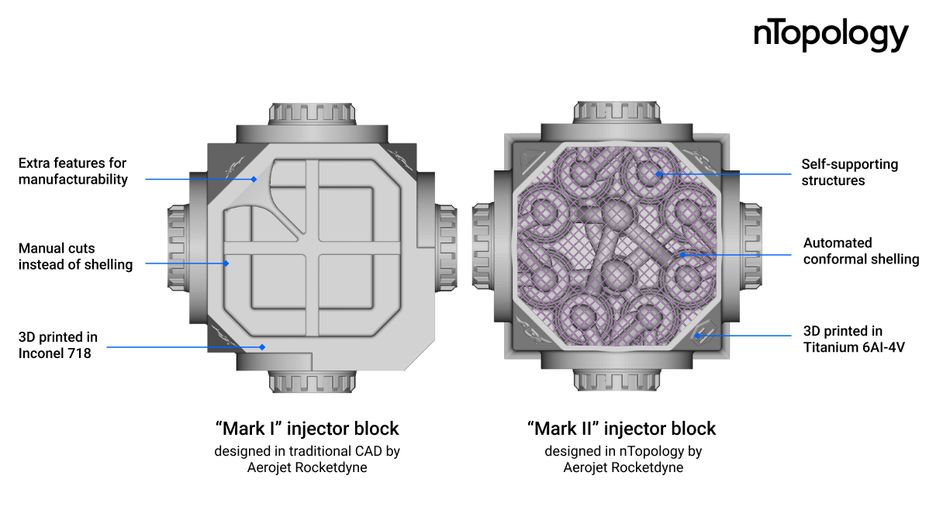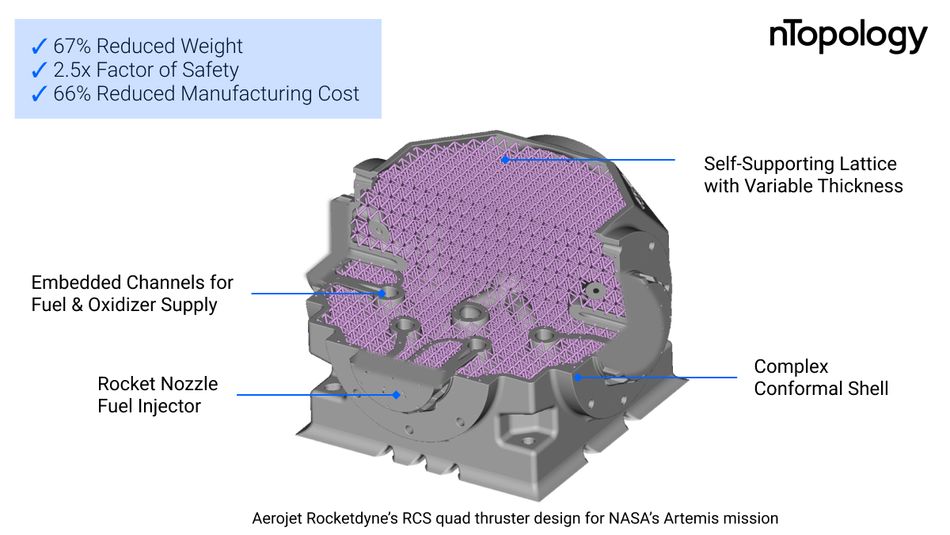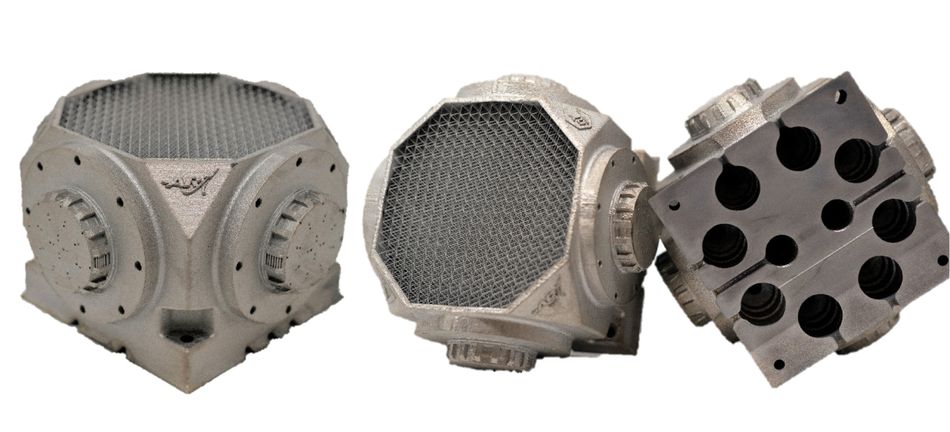Aerojet Rocketdyne's 3D Printed Quad Thruster Enables Low-Cost Space Exploration
Aerojet Rocketdyne engineers optimized a key component of their Reaction Control System (RCS) quad thruster using additive manufacturing. Not only is the new space engine part 67% lighter, but it also contributes to the reduction of the overall production cost of the thruster by 66%
This article was first published on
ntopology.comAerojet Rocketdyne engineers optimized a key component of their Reaction Control System (RCS) quad thruster using additive manufacturing. Not only is the new space engine part 67% lighter, but it also contributes to the reduction of the overall production cost of the thruster by 66% enabling fast, economical, and sustainable lunar exploration.
Background
It has been almost 50 years since humanity’s last visit to the moon, with the astronauts of the Apollo 17 mission landing on the lunar surface on December 11, 1972.
Five decades later, NASA’s Artemis program prepares our return to the moon. The ambitious end goal is to build a permanent base camp on the moon’s surface and a station in lunar orbit. Now, the question is: “what will our next trip to the moon look like?”
Aerojet Rocketdyne is a world-class manufacturer of advanced energetic systems involved in the development of the propulsion for NASA’s Orion Spacecraft and Space Launch System.
The engineering team’s objective is to redesign legacy systems from the Apollo-era program using modern propulsion, design, and manufacturing technologies to drive down costs, speed up development and production time, and improve performance.
“If we leverage the advantages that we made over the last decade in engineering software and manufacturing hardware, we can build critical subsystems at fractions of the traditional cost while improving on the performance of heritage designs.”— James Horton, Mission Architect at Aerojet Rocketdyne
In this case study, we cover the process that the team followed to optimize weight and cost key components of the Reaction Control System (RCS). This system controls the altitude and orientation of the spacecraft and lunar lander when they are in flight.
Redesigning the Reaction Control System
The RCS consists of four service modules placed around the spacecraft and lunar lander. Every module features four thrusters, each facing the four principal directions. This quad thruster setup can fire independently to control the spacecraft’s speed, yaw, pitch, and roll, exerting up to 100 lbf (or 445 N).
For the Apollo program, NASA commissioned the manufacturing of more than 600+ individual thrusters to support 12 human spaceflights and testing and qualification. Reducing the cost of these thrusters can make a significant dent in the total cost and affordability of the Artemis program.
“As with any complex endeavor, the more affordable you can make it, the greater the chance that you will ensure its completion, and the moon is no different. Metal additive manufacturing plays a key role in achieving these goals.”
— James Horton, Mission Architect at Aerojet Rocketdyne
The legacy design of the RCS module was an assembly that consisted of the four thrusters, the manifold that feeds the fuel and oxidizer, and a multi-part thin-walled casing to piece everything together. James Horton, aerospace engineer and mission architect at Aerojet Rocketdyne, and his team identified many opportunities for improvement.
The team decided to double down on additive manufacturing to improve the affordability of the legacy design and reduce the complexity of the build. The ability to reduce the number of components through part and function consolidation minimizes the cost of touch labor. Assembly consolidation also reduces the potential points of failure, increasing the system’s reliability.
Aerojet Rocketdyne’s engineers also decided to incorporate advancements in rocket propulsion technology to improve the system’s performance. They moved to MMH and MON-25, a new rocket fuel and oxidizer combination. MON-25 provides more reliable restart, is easier to store during long space flights, and requires less energy to prevent freezing, reducing the system’s overall energy consumption and weight.
However, thrusters that use MON-25 require a more efficient fuel delivery mechanism and intricate design for the nozzle and plumbing of the injector block.
From Concept to Qualification-Ready
Aerojet Rocketdyne demonstrated the feasibility of this approach by completing hot-fire testing in 2019. However, the first design iteration of the injector block (or “Mark I”) was not optimized for weight, manufacturability, and cost. The team decided that further refinement was necessary to make their proposal economically viable.
“Every single pound of material you can remove from a spacecraft saves money on launch costs. That’s why we used nTopology to optimize the design, and then Velo3D’s system to build it.”
— James Horton, Mission Architect at Aerojet Rocketdyne
“Shell and Infill” for Lightweighting
For the second iteration, the team applied a simple lightweighting concept. First, create a shell to remove unnecessary material. Then, fill it with a lattice structure to ensure manufacturability and increase stiffness.
The shell and infill approach is easy to conceive, but it was impossible to implement using traditional CAD software due to the complexity of the internal channels. The shelling function would simply fail, and the software would crash. The team spent many hours trying to troubleshoot this issue with no success during the development of their “Mark I” design.
On the other hand, with nTopology’s implicit modeling engine, they successfully shelled the part on their first attempt. As a bonus, filets could be added to all edges to alleviate stress concentrations and improve the part’s fatigue strength.
To further refine the structure, Horton’s team controlled key design parameters using field-driven design, another unique capability of nTopology. For example, they created a smooth transition in the lattice beam thickness — thinner in the center and thicker near the shell — to further reduce the part’s weight.
In a few hours, Aerojet Rocketdyne’s engineers created a manufacturing-ready design candidate with a 2.5x factor of safety based on the maximum tubing pressure.
From Design to Manufacture
The team used a Velo3D Sapphire metal 3D printer to manufacture the part. This system enables the manufacturing of steeper overhangs and finer details than conventional metal laser powder bed fusion systems.
The material selected for this project was Titanium 6Al-4V which is typical material for bipropellant thrusters. Titanium has approximately half the density of Inconel 718, the material used to manufacture the previous design iteration, contributing to the parts weight reduction. However, it is notoriously more difficult to 3D print due to thermal effects and cracking.
Nevertheless, the team successfully 3D printed the part in a flat orientation, which improved the surface quality of the nozzle flanges and injector faces. Moreover, no support material was necessary to manufacture the plumbing’s internal channels, and the intricate lattice was 3D printed without any defects.
The Next Steps
The additively manufactured injector block is an intrinsic part of Aerojet Rocketdyne’s efforts to develop an RCS module that is 1/5 the mass, 1/2 the size, and 1/3 the cost of conventionally manufactured alternatives.
“I didn’t know if it was even possible to do this type of integration. We have shown that this is a viable path to affordability by reducing part count and touch labor. I am looking forward to bringing this product into space.”
— James Horton, Mission Architect at Aerojet Rocketdyne
This case study was first published on the nTopology blog.





